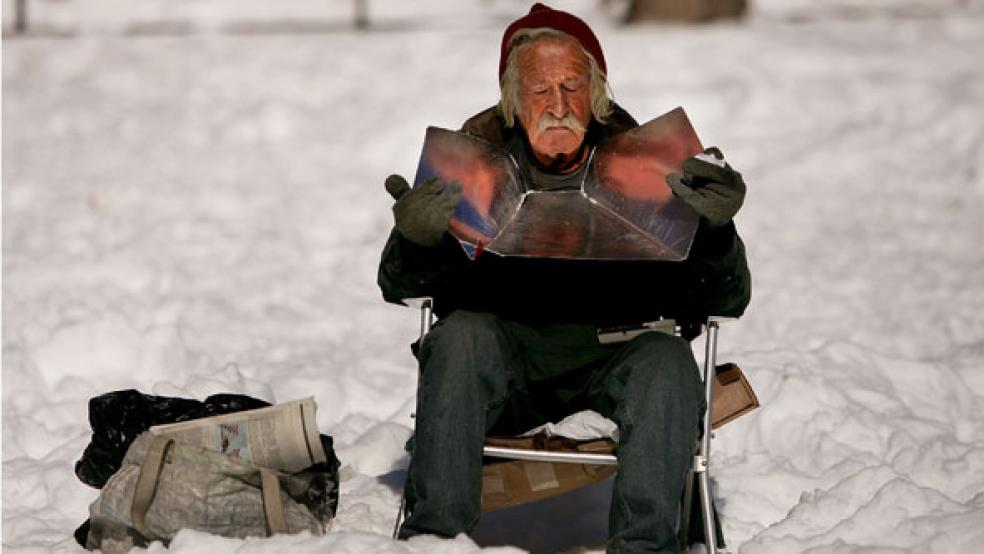The budget crisis is forcing some pretty cold political calculations, and this one ranks right up there. Amid stubbornly high unemployment and rising energy costs, Congress and the Obama administration are poised to slash spending for low-income home heating assistance by 20 percent or more. This, at a time when the poverty rate has risen to 15.2 percent, one of the highest in the past 28 years.
Like two former chief executives, President Obama last February requested $2.57 billion to fund the Low Income Energy Assistance Plan or LIHEAP in his 2012 budget, a 50 percent reduction from the most recent $5.1 billion level authorized by Congress. The budget, of course, was never approved. Obama said he was justified cutting the program by half because of the sharp decline in projected energy costs. "Energy prices have now gone down but the cost of the program has stayed the same," he said at a press conference in February. "Let’s go back to a more sustainable level." Critics said the Administration’s forecast was flawed. Former presidents George H.W. Bush and Clinton both tried unsuccessfully to scale back the program.
Cutting home heating subsidies for the poor would seem like a bad idea for President Obama and Democratic and Republican lawmakers heading into a crucial election year. However, with Congress and the White House eagerly seeking spending cuts, LIHEAP looms as a fat target.

LIHEAP, in fact, has been awash with funds for the past three years as the Bush and Obama administration went along with a doubling of spending, from $2.5 billion to $5 billion a year, to help low-income Americans cope with a huge spike in energy costs. During the 2006-2007 winters, the average cost of home heating oil was $2.42 per gallon, but then a year later the cost skyrocketed to $3.33 per gallon. But when heating fuel costs began to drop last winter to $2.85 per gallon, President Obama proposed cutting the program by half. But lower prices did not hold.
Because LIHEAP provides both heating and cooling subsidies to residents of every state in the country, lawmakers on Capitol Hill wouldn’t tolerate so deep a cut that would affect so many constituents. But experts say that even the $1 billion of LIHEAP cuts now under consideration by Congress will cause serious hardships to the unemployed and poor – especially New Englanders, who make up 75 percent of all heating oil customers.
On Wednesday, the problem was brought into sharper relief when the Energy Information Administration released projections that heating fuel costs this winter will average $3.71 per gallon, a 25 percent increase over last year and the highest average price on record. Household expenditures for heating oil are expected to increase an average of eight percent or a total of $193 this year because of a 10 percent increase in heating oil prices.
LIHEAP—created in 1981 on the heels of the 1970s energy crisis—is designed to help struggling families make ends meet by offsetting some of their home heating and cooling costs. It helps those with the lowest incomes that pay a high proportion of household income for home energy.
Eligibility requirements vary from state to state, but federal law says household income must not exceed 150 percent of the poverty level or 60 percent of the state median income in order to qualify. LIHEAP doles out money to states, then local relief agencies review financial data of applicants. Eligible applicants have the money credited to their accounts with the local utility company.
There is no way to forecast with certainty how many households will be adversely affected by the proposed cuts in LIHEAP pending before Congress. The states would have the option of reducing benefit payments or dropping some households from the rolls. Mark Wolfe, of the National Energy Assistance Directors’ Association, an organization that represents state aid officials in Washington, estimated that up to two million households could be adversely affected by the cuts.
Long, cold winters and a heavy reliance on expensive heating oil make New England particularly vulnerable, Wolfe said. “It’s a very dramatic cut and we don’t see the number of households [needing assistance] going down,” Wolfe said. Roughly 8.6 million households received a LIHEAP benefit last year, an increase of nearly three million since 2008.
With a sputtering economy and a poverty rate swelling to nearly 1 in 6 Americans last year, advocates argue that this social safety net program is essential.
Heating costs vary greatly, depending on the size of the home, location and how careful people are in turning down their thermostats.
For a family of four in New Hampshire, the average LIHEAP benefit is $700, which buys about 200 of the 800 gallons needed to heat many of the qualifying households throughout the winter, said Celeste Lovett, Fuel assistance program manager with the office of energy and planning.
Last year just over 47,000 New Hampshire households (out of 134,000 eligible) received a LIHEAP benefit. The state has been accepting applications since the middle of July and is already close to 25 percent of its caseload.
"New England winters are often harsh, but with impending budget cuts to programs that serve the neediest, including LIHEAP, this could be a historically severe winter,” said Democrat Rep. Edward Markey of Massachusetts. “Cutting funds for this critical program would mean that tens of thousands of Massachusetts families could have their heating cut off this winter.”
While LIHEAP has many friends, it also has many detractors, who think it constitutes a generous handout that the federal government no longer can afford. Isabel Sawhill, who spearheaded former President Bill Clinton’s unsuccessful effort to cut LIHEAP when she was associate director of the Office of Management and Budget for social programs, said the program should be eliminated, and she wouldn’t be surprised if Congress eventually phased it out. The problem, Sawhill said, is that LIHEAP targets a very narrow area of spending.
“I support providing general assistance to low income families but I think we have too many special purpose programs in our arsenal right now,” said Sawhill, a senior fellow at the Brookings Institution. “It makes sense to simplify the system and consolidate some of these programs.”
With Congress and a “Super Committee” committed to approving at least an additional $1.2 trillion of deficit reduction this fall, the heating aid program could easily get caught up in the cutting frenzy. Over the past three years, LIHEAP funding has hovered around $4.7 billion. In the fall of 2008, the government responded to the dramatic spike in energy prices and doubled the assistance, from $2.5 billion to $5.1 billion, to states.
Jacob (Jack) Lew, Director of the Office and Management and Budget, and others in the administration conceded that the cuts would cause hardship and said they would keep a close eye on energy costs to see whether they were creeping up again.
In the meantime, New England states are bracing for deep cuts. “We ride the LIHEAP funding rollercoaster every year,” said Richard Moffi, Fuel Assistance Program Chief in Vermont. “This is nothing new. But when the President proposed to cut it in half and the House followed, it got very scary.”





